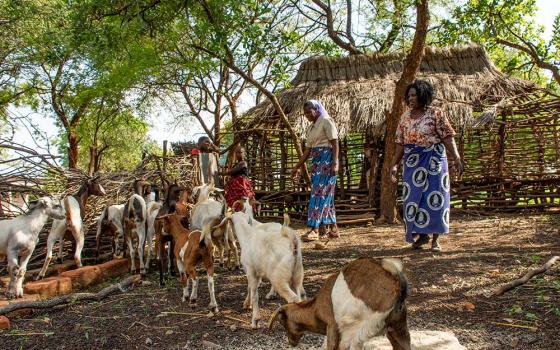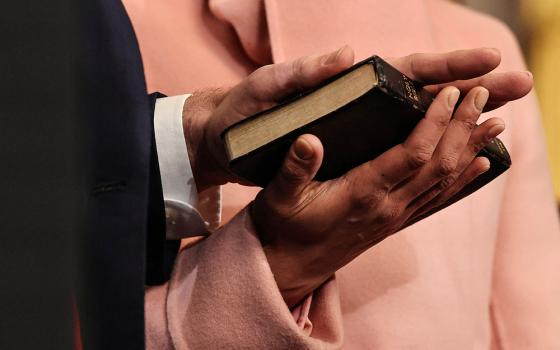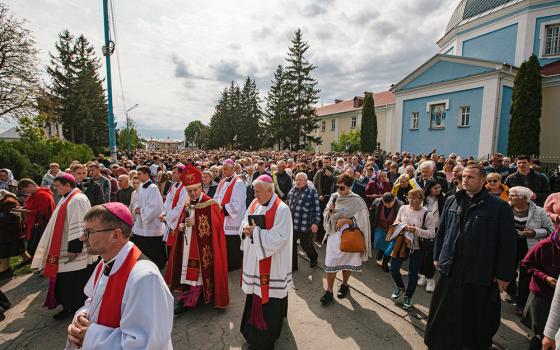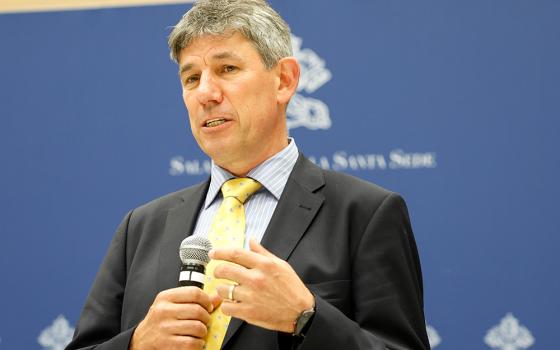Mid-October in Rome is sort of like sweeps week for American TV, meaning that it’s when everybody rolls out their most compelling programming. There’s always a glut of activity, and this week offered a classic case in point. Some highlights:
- The Synod of Bishops for the Middle East, fleshed out by a parallel series of cultural events intended to promote Christianity in the Holy Land, and a number of sessions with the press – some organized by the Catholic Near East Welfare Association and Canada’s Catholic media network “Salt and Light,” and others with the Jewish and Muslim representatives invited to address the synod.
- An Oct. 12 conference on interfaith action sponsored by the U.S. Embassy to the Holy See and the Pontifical Gregorian University, featuring a keynote address by Joshua DuBois, who runs the White House office for Faith-Based and Neighborhood Partnerships.
- An Oct. 15-16 symposium on Caritas in Veritate, Benedict XVI’s recent social encyclical, sponsored by the Pontifical Council for Justice and Peace and the U.S.-based Institute for Advanced Catholic Studies.
- The canonization on Sunday of six new saints, including the first Australian, Mary MacKillop, and the first member of the Congregation of the Holy Cross, Brother André Bessette of Montreal.
- Publication of a motu proprio formally creating the new Pontifical Council for Promotion of the New Evangelization, presented in a Vatican briefing on Tuesday by the first president of the council, Italian Archbishop Rino Fisichella.
- Anticipation of Pope Benedict XVI’s nomination of new cardinals, which should be announced soon, with the consistory set for Nov. 20-21. The list will likely include two Americans: Archbishop Donald Wuerl of Washington, D.C., and Archbishop Raymond Burke, Prefect of the Apostolic Signatura. (Another American candidate, Archbishop Timothy Dolan of New York, may have to wait for the next go-around.)
- The grand opening of a new pub in Rome dedicated to the memory of Pope John Paul II on Thursday. (OK, that probably doesn’t belong on the list, but it’s charming nonetheless).
Trying to sum all that up in a neat sound-bite would be silly, but suffice it to say that collectively these events say much about the challenges, and the opportunities, facing Catholicism in the early 21st century.
The Synod
I’m filing daily reports on the synod, which can be found at http://ncronline.org/mideast_synod. Here, I’ll simply offer a few fleeting observations.
At the big-picture level, the story this synod is trying to tell is a compelling drama: A tiny Christian community squeezed between a Jewish state and a vast Muslim sea, in some cases fighting off virtual demographic extinction, yet dreaming great dreams about contributing to a democratic revolution and the construction of a “positive secularism.” Especially for Christians in the West who sometimes feel frustrated with a church that can seem too big, too addicted to power and privilege, the situation of Christianity in the Middle East offers a remarkable shift in perspective.
So far, the concerns expressed in the synod can be grouped into matters ad intra and ad extra, meaning the church’s internal life and its mission in the outside world.
Ad intra, one frequently voiced aim is overcoming “denominationalism,” meaning a lack of real communion among the six Eastern Churches of the Middle East (Armenian, Chaldean, Coptic, Melkite, Maronite, and Syrian) as well as the Latin Rite. The perception is that a sort of tribalism among the various churches often impedes cooperation in facing the region’s challenges.
One concrete suggestion is that all the Catholic bishops of the Middle East ought to assemble on a regular basis, in somewhat the same way that the bishops of Latin America meet under the guise of CELAM, the Asians under FABC, and the Africans under SECAM. (The synod is actually the first time all these bishops have met together.)
Another key ad intra issue has been defending the identity and heritage of the Eastern Churches vis-à-vis the dominant Roman, or Latin, tradition within Catholicism. Some Eastern bishops have called for the ordination of married priests for Eastern believers in Europe and North America, or extending the authority of the Eastern patriarchs to include these diaspora communities, though neither idea appears to enjoy unanimous support.
There seems sentiment among Western bishops at the synod to defer to whatever the Eastern bishops propose. During a press conference on Wednesday, Archbishop Allen Vigneron of Detroit signaled that if the Eastern bishops believe the ordination of married priests is important for their communities in North America, he wouldn't be opposed.
Ad extra, the main aspiration is to see Christianity as a catalyst for a broad social transformation in the Middle East, towards genuinely democratic societies based on the rule of law and a healthy distinction between religion and politics. For the Christians of the Middle East, “secularism” does not mean an attack on religion; instead, it’s the alternative to theocracy and a sort of permanent second-class citizenship.
Greek-Melkite Patriarch Gregorios III Laham of Syria called efforts to bring peace and democracy to the Middle East the region’s “Great Jihad.”
Naturally, inter-faith dialogue is also a core ad extra concern for the Christians of the region. This week, the synod heard from three representatives of the other great religions of the Middle East. Rabbi David Rosen, representing the Grand Rabbinate of Israel, addressed the bishops on Wednesday, while two Muslims spoke on Thursday: an advisor to the Grand Mufti of Beirut, Mohammed al-Sammak, a Sunni, and Ayatollah Sayed Mostafa Muhagag Ahmadabadi, a professor of Islamic Law in Iran and a Shi’ite.
While it’s unlikely that some world-changing new idea will come out of the synod, it perhaps can at least galvanize Catholicism at the leadership level to devote greater time and treasure to supporting Christianity in what is arguably the part of the world today where it is most imperiled.
The conference
Anyone who has ever attended a conference in Rome knows they tend to be top-heavy on theory, and Americans in particular often chafe at what they perceive to be a lack of practical application. The Oct. 12 conference sponsored by the U.E. Embassy to the Holy See was deliberately crafted to be an exception, emphasizing concrete examples of what works when followers of various religions join forces to pursue a shared humanitarian goal.
The title of the event was, “Building Bridges of Hope: Success Stories and Strategies for Interfaith Action.”
Participants included Christians of various churches, Jews, Muslims, Hindus, Buddhists, not just from the United States but other parts of the world. It met in the aula magna of the Gregorian University, where Archbishop Pier Luigi Celata, secretary of the Vatican’s Pontifical Council for Interreligious Dialogue, offered the opening invocation and then stayed for the discussion.
During the day’s panel events, speakers offered a slew of practical examples of cooperation, including an interfaith effort to resolve a garbage epidemic in Ghana, anti-Malaria efforts in Nigeria, Habitat for Humanity and its “theology of the hammer,” a partnership between Muslims in Morocco and Protestant Evangelicals in the United States in support of action on climate change, and the efforts of Islamic relief organizations in the predominantly Christian area of southern Sudan.
U.S. Ambassador to the Holy See Miguel Diaz told participants that when religions roll up their sleeves and work together, they represent a “force multiplier for a better world.”
DuBois offered a similar ferverino.
“Every day, brick by brick, you continuously lay the moral and intellectual foundation of our public life and dialogue,” DuBois told participants. “You are the ‘first responders’ when, for various reasons, that foundation is shaken.”
DuBois argued that humanity’s shared experience of pain and suffering, from ancient Egypt to contemporary New Orleans post-Hurricane Katrina, illustrate the urgency of interfaith solidarity.
“Across all religious traditions, we face tremendous challenges around the globe, some too daunting to fully comprehend. 33 million people wracked by HIV/AIDS,” DuBois said. “Over 140 million orphans worldwide. Religious tensions from the Middle East to Europe to the United States. A warming climate and frequent natural disasters, from Haiti to Pakistan and so many points in between.”
“If we are to tackle these challenges, we must somehow find a way to put aside religious difference and work together,” he said.
On background, both Vatican officials and other diplomatic observers in Rome said this week that Diaz continues to make a positive personal impression, buttressed by his wife, Marian, an engaging personality and accomplished theologian in her own right. (She’s recently agreed to teach next semester at the Gregorian.)
Diaz is seeking ways to exploit possible areas of cooperation between the Obama administration and the Vatican, but those efforts are still to some extent bogged down by three factors: Obama remains an ambivalent figure in some sectors of Catholic opinion in the States because of his stance on life issues; some elements within the U.S. State Department aren’t inclined to take the Vatican seriously; and the Vatican’s own diplomatic apparatus seems to be going through a period of retrenchment, pulling back from new initiatives.
The symposium
The symposium on “Caritas in Veritate” in the United States being held today and tomorrow at the Pontifical Council for Justice and Peace was put together by the U.S.-based Institute for Advanced Catholic Studies, whose president is Marianist Fr. James Heft. (Was there ever a better last name for a serious Catholic intellectual?)
The event brings together a cross-section of leading lights on the intersection of faith and public policy in the United States, including Mary Jo Bane from Harvard, Under-Secretary of Commerce Rebecca Blank, Jesuit Fr. John Coleman, Daniel Finn of St. John’s University, Fr. Brian Heihr, Franciscan Fr. Kenneth Himes, Jesuit Fr. David Hollenbach, Katherine Marshall of Georgetown, Bishop William Murphy of Rockville Center, and a slew of others. Diaz will also be on hand.
I’ll be taking part in the conversation, trying to offer a reading on the reception of “Caritas in Veritate” from the point of view of communications and Catholic life in America. Given the mix of perspectives and experiences in the room, it ought to make for a fascinating conversation.
I’ll post some reflections on the symposium when it’s over.
The Canonizations
Among Sunday’s six new saints, the highest profiles probably belong to MacKillop and Bessette. Both were fascinating personalities in their own time, and remain compelling figures today.
MacKillop (1842-1909) is the first Australian saint. She was the founder of the Sisters of St. Joseph of the Sacred Heart, and a dedicated educator. Part of her appeal is that MacKillop was a strong woman leader, at a time when Catholicism was still very much a boy’s club. She was briefly excommunicated for alleged “insubordination” to her bishop, but she stood her ground.
Brother André, the “Miracle Man of Montreal,” is a bit like the Padre Pio of Canada: a simple man of the people, far from the corridors of ecclesiastical power, whose reputation for healing power and other spiritual gifts drew a steady stream of devotees. He worked most of his life as a doorkeeper, and spent much of it in poor health, yet he became one of the architects of the church in Canada and inspired the massive Oratory of St. Joseph in Montreal.
Brother André too faced hostility from some quarters of the church, in this case members of his own order who looked askance at his fame and his reputation for the miraculous.
It may be a sign of the times that the media have attempted to link both new saints to the sexual abuse crisis, though in both cases the connection seems tenuous.
In the case of MacKillop (1842-1909), recent reports in Australia have suggested that the “insubordination” triggering her excommunication was related to her order’s determination to uncover a case of sexual abuse by a priest. According to that reconstruction, allies of the priest schemed to have MacKillop excommunicated in revenge for exposing the abuser.
On the strength of that account, American Jesuit Fr. James Martin proposed that MacKillop be regarded as a “patron saint” of victims of sexual abuse.
Alas, the universally acknowledged authority on MacKillop’s life, Australian Jesuit Fr. Paul Gardiner, says it ain’t so. Gardiner says that while members of the order did indeed report the priest’s abuse, MacKillop herself was out of town at the time and had nothing to do with it.
Gardiner said dragging MacKillop into the story represents a “nasty swipe” at the Catholic church, a way of reviving public attention to the crisis on the back of MacKillop’s popularity in Australia. (That popularity is certainly reflected in the streets of Rome this week; sometimes it feels like every Australian Catholic alive is here.)
Something similar happened recently in Canada, where the Canadian Broadcasting Corporation timed a radio report about allegations of sexual abuse against members of the Holy Cross order, which reportedly took place at a Montreal institution associated with Brother André, to coincide with the run-up to the canonization. That’s despite the fact that Brother André died in 1937 and had nothing to do with the reported abuse.
Even if neither saint is truly a patron for the abuse crisis, both certainly had an uneasy relationship with the powers-that-be in the church of their day. In that sense, both might find an even broader appeal as patrons for frustrated Catholics who sometimes chafe at officialdom – an appeal, presumably, that will never go out of style.
The new dicastery
Over the years, few figures in Catholicism have grumbled more often, or more eloquently, about the dangers of ecclesiastical bureaucracy than Joseph Ratzinger. In 1988, for example, then-Cardinal Ratzinger wrote: “In the past two decades an excessive amount of institutionalization has come about in the church, which is alarming. … Future reforms should aim not at the creation of yet more institutions, but at their reduction.”
Especially in that light, the recent decision of Pope Benedict XVI to create yet another layer of bureaucracy – in this case, a new Pontifical Council for Promotion of the New Evangelization – is striking.
The stated ambition of the new council is to revive the faith in traditionally Christian territories, above all Europe.
Certainly no one doubts the extended “ecclesiastical winter” gripping many parts of Europe. It can be seen in single-digit Mass attendance rates in some nations, a dramatic decline in the church’s public influence, and the erosion of traditional respect for ecclesiastical institutions – for example, recent police raids against church properties in Belgium and an investigation in Italy of the Vatican Bank.
The $64,000 question seems to be whether the new office, known in technical Vatican parlance as a “dicastery,” is something more than a hollow bureaucratic gesture, with little realistic chance of reversing cultural currents that have been building for more than five centuries.
Italian Archbishop Rino Fisichella, the first president of the new council, presented the pope’s motu proprio formally creating the office, in a Vatican briefing this week.
Fisichella didn’t offer much clarity about what the council intends to do; in fact, the lone concrete project on the docket at the moment would appear to be a celebration of the 20th anniversary of the Catechism of the Catholic Church in 2012.
Instead, Fisichella offered both an assurance and an invitation.
The assurance was that neither he nor his boss, Pope Benedict, is a bureaucratic personality, and that the objectives here are evangelical rather than institutional.
The invitation was to patience, stressing that he doesn’t even have a computer in his office yet to get on the Internet.
“When a baby is born, the parents want to think right away about what it will do when it’s grown up,” Fisichella said. “Right now, however, I’m satisfied to think about the things the baby needs.”
The new cardinals
Sometime soon – perhaps as early as Sunday during the Angelus address, but certainly not long after the close of the Synod of Bishops – Pope Benedict XVI is expected to announce a consistory for the creation of new cardinals, to be held in Rome Nov. 20-21.
Among the roughly 20 new cardinals the pope is expected to announce, two are likely to be Americans: Wuerl and Burke.
Dolan of New York is another American prelate certain to become a cardinal at some future point, but it looks like he may have to wait his turn in line. Just as Benedict XVI is a stickler for not exceeding Paul VI’s ceiling of 120 voting age cardinals (that is, cardinals under the age of 80), he also seems determined to follow the tradition of not naming a new cardinal in an archdiocese as long as its former cardinal-archbishop is still under 80. Retired Cardinal Edward Egan of New York will not pass that threshold until April 2012.
The main story line of the November consistory is likely to be “The Revenge of the Italians.” Though popes since Paul VI have been committed to internationalizing the College of Cardinals, almost half of Benedict’s nominees this time are expected to come from il bel paese. Seven hold senior Vatican offices:
- Archbishop Angelo Amato, Congregation for the Causes of Saints
- Archbishop Mauro Piacenza, Congregation for Clergy
- Archbishop Fortunato Baldelli, Apostolic Penitentiary
- Archbishop Velasio De Paolis, Prefecture for the Economic Affairs of the Holy See
- Archbishop Gianfranco Ravasi, Pontifical Council for Culture
- Archbishop Francesco Monterisi, Archpriest of St. Paul Outside the Walls
- Archbishop Paolo Sardi, Patron of the Knights of Malta
There are also two Italians in dioceses traditionally led by cardinals likely to be tapped: Archbishops Paolo Romeo in Palermo and Giuseppe Betori in Florence.
During the last five years, there has already been considerable talk about the “re-Italianization” of the Roman Curia under Benedict XVI, fueling what some see as an excessively parochial outlook at senior levels. The preponderance of Italians in the coming consistory probably won’t do a great deal to change those perceptions.
Among the new crop of cardinals, the lone slam-dunk new papabile would seem to be Ravasi.
A native of Italy’s Lombardy region, Ravasi’s father was an anti-fascist tax collector who deserted the army and was missing from his family for 18 months. Ravasi has always been drawn to the life of the mind, and originally wanted to be a Greek and Latin teacher. After deciding to enter the seminary instead, he studied at the Pontifical Biblical Institute in Rome and worked on archeological projects in the Middle East.
Back in Italy, Ravasi moved in clerical circles in Milan, collaborating with his fellow thinker-prelate Cardinal Carlo Maria Martini, though Ravasi was seen as a more “Ratzingerian” figure than the more liberal Martini, a Jesuit. After a brief glitch in his appointment to the episcopacy in 2005, related to an article he wrote on Easter which some regarded as heterodox, Ravasi was appointed to head the Pontifical Council for Culture in 2007.
I’ve described Ravasi as a man “with the mind of Ratzinger and the heart of Roncalli,” meaning that he combines the intellectual acumen and clarity of Benedict XVI with the warm pastoral touch and openness to the world of John XXIII. As a result, he tends to be one of those rare figures with strong appeal across the ideological and theological divides in the church.
He’s also a polyglot, comfortable in all the major European languages (including English), and a widely traveled figure who knows the situation facing the church in different parts of the world.
Given all that, it’s not hard to see why many people believe Ravasi, who turns 68 next Monday, will become a front-runner in the informal papal sweepstakes immediately upon claiming his red hat next month.
[John L. Allen Jr. is NCR senior correspondent. His e-mail address is jallen@ncronline.org.]
Editor's Note: We can send you an e-mail alert every time Allen's column, All Things Catholic, is posted to NCRonline.org. Go to this page and follow directions: E-mail alert sign-up. If you already receive e-mail alerts from us, click on the "update my profile" button to add Allen to your list.




